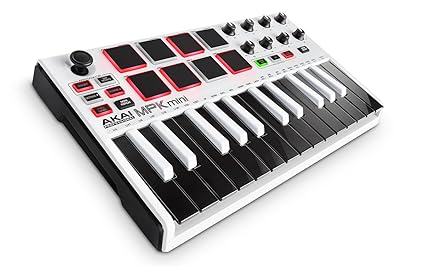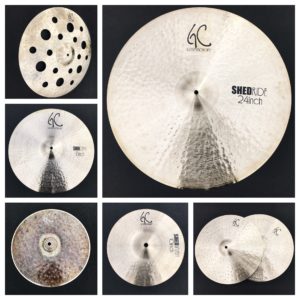Best MIDI Keyboards 2022

Since technology is improving constantly, MIDI keyboards are getting better and cheaper. With a wider range of MIDI controllers to pick from, the choice only gets tougher. The decision to go with one controller over another boils down to the finer details and how they fit with your personal preferences. However, if you still can’t decide on the keyboard you want to buy for your MIDI set up, here are a few things you should consider:
• Type of keys: There are three kinds of keys: synth-action, semi-weighted, and full-weighted. Synth-action keys use spring-action to restore their position, semi-weighted keys use a spring and a weight to restore the position, and fully-weighted keys use weight. Most MIDI keyboards have synth-action keys. Fully-weighted keys are more common with expensive controllers because they are closer to pianos.
• Number of keys: The most common number of keys you can find on a MIDI controller are 25 (for a mini-controller), 49 (the most common), 61, and 88 (the number of keys in an actual piano). There are other variants in between including 32 and 37-key controllers. The number of keys dictates the size of the MIDI keyboard. For instance, if you want something compact that you can carry around, the 25-key version will easily fit in a backpack or gig bag.
• Your budget: There’s something for everyone with regards to price. You can find some USB MIDI keyboards going for less than $100 and others even surpassing $500. The rule of thumb here is: Expensive does not always translate to the best controller.
Other elements are worth considering but we cannot fit them all here. Now, choosing the best MIDI keyboard is not easy, but these four quality options are the best of the best:
Akai MPK Mini mk2


Akai MIDI mini keyboards have been a staple for many musicians and hobbyists, and with good reason. The compact keyboards Akai Professional make score high in terms of functionality and quality. They are also popular because they are relatively cheap. First off, Akai MPK Mini mk2 was launched to succeed the MPK Mini, which was a huge success. Musicians and producers loved it and that means that the bar has to be raised for the mk2.
The Mini mkII has the following features:
- 25 synth-action keys
- 4 Thumbstick (pitch control and dynamic modulation)
- 8 velocity-sensitive backlit pads
- 8 Q-link knobs
- Octave +/- buttons
- Built-in Arpeggiator
- Software bundle (more on this later)
The Build
Akai Professional doesn’t mess around with the stability of their products. You’re assured of a solid and compact MIDI controller when you buy from them and the Mini MK2 doesn’t disappoint. It’s built to last if you take care of it. Although it is sturdy, don’t bump it or let it fall.
The pads are not necessarily high-end but most people don’t mind that because having 8 pads on a mini keyboard is impressive. Besides, those pads will remind you of the Akai MPC series.
Compactness
The main purpose of buying a mini keyboard is to have something functional yet compact. You’ll like how easy it is to carry around and pack. That being said, the size of the keys can take some getting used to if you normally work with bigger keyboards. You may also find it difficult to play with both hands.
Functionality
The Mini mk2 comes with a software lineup comprising of Air Music Hybrid 3 synth, Sonivox Wobble, and Akai Pro MPC Essentials.
If you have a bit of experience with MIDI controllers, once you get used to the keys, the mk2 is easy to work with. It maps pretty well with the standard DAWs but you may have to configure it to suit your style.
M-Audio Axiom AIR

Axiom AIR is one of the better models created by M-Audio. The Axiom Air is an improvement on its predecessor, the Axiom Pro. It’s built to be ergonomic and easier to work with. If you are into percussions, you will appreciate its high-quality pads (compared to its competitors). The HyperControl mode in the Axiom Pro had its fans and detractors. M-Audio listened and they improved on that with the Axiom AIR.
Let’s go over the key features of the Axiom Air:
- Variants are 25-key, 49-key, and 61-key (No 88-key).
- Synth-action keys that have the aftertouch feature.
- 12 drum pads, 8 encoders and 9 faders (49 key)
- Software bundle: Ignite by Air and Pro Tools Express
- Backlit screen for better user experience.
The build
Overall, the Axiom Air is built to last. One of the most notable improvements is the slightly-tilted, orange-backlit screen – a departure from the harder-to-view flat screen on the Axiom pro. The 12 drum pads are a step up from Axiom Pro’s 8. The knobs and faders are firm yet responsive.
Functionality
The playing surface is responsive to pressure making it easier to manipulate the aftertouch feature. You can also work the velocity curves better if you want to add dynamics to your music.
For flexibility, there are separate toggle switches to assign MIDI and HyperControl functions to sliders and knobs, which give you better control over the keyboard. There are also separate HyperControl buttons to allocate Inst/FX and Mix to the rotary knobs and the faders – with these functionalities, you can run the Axiom Air as a standalone unit.
The controller comes with HyperControl software for DAW mapping. Although you don’t have to use them, Axiom Air comes with the Ignite package (by Air Music Technology) and Pro Tools Express.
M-Audio Oxygen
The M-Audio Oxygen range of controllers is considered beginner-friendly. This can be attributed to the fact that it is easy to set up and you can start working with it straight out of the box. However, it is by no means an inferior MIDI controller. The latest Oxygen series does not come with a MIDI jack. Therefore, if you want to work with peripheral devices like drum machines, you have to incorporate a MIDI interface.
Its key features are:
- Comes in 25-key, 49-key, and 61-key.
- Software bundle includes Air Xpand!2, Ableton Live Lite, and SONiVOX Twist.
- 8 drum pads and 8 MIDI knobs (the 49-key keyboard has 9 faders)
- Pitch and mod wheels
- LED display to give the user an intuitive gist of the active MIDI control
- Auto-assign feature powered by the “Auto” button.
Build
The new series is better than the older versions in terms of durability. For instance, the new faders are sturdier and, therefore, less likely to break off than the previous generations’ faders. The knobs and switches are also less prone to breakage.
Although M Audio Oxygen controllers have a robust structure, they are not too heavy. The color scheme (black and orange) is a bit bland but you can’t let that play too much into your decision to buy it unless you want something flashier.
Functionality
The drum pads and the keys are velocity-sensitive – properties we’ve come to expect of new generation MIDI controllers. The backlight of this controller, especially on the tiny notches on the knobs, is not strong enough to show you where the knobs are positioned in poorly-lit environments. Consequently, it is better suited to adequately lit environments like studios.
To bring an element of versatility to the controller, you can map the drum pads to CCs and MIDI notes. The Auto-assign function makes it easier to integrate the keyboard with standard DAWs – makes it easier for learners to work with Oxygen controllers hassle-free. For example, Ableton Live Lite gels very well with the auto-assign feature.
Novation Impulse


Novation Impulse is quite popular with professionals and hobbyists. It is popular with learners because it integrates seamlessly with the major DAWs. The Novation Impulse is relatively cheap for a MIDI keyboard of its quality. The fact that the keys are semi-weighted makes it feel more like an instrument rather than a mere computer accessory.
Its main features are:
- Comes in 25-key, 49-key, and 61-key variants
- Semi-weighted keys
- 49-key keyboard has 9 faders, 8 rotaries, and 8 drum pads
- Transport controls
- LCD screen
- Auto-assign feature
- Software bundle: Ableton Live Lite, Loopmasters sample library, Mike the drummer, and Novation bass station
Build
The manufacturer pulled all the stops with the hardware. The knobs and the faders are a delight because they are sturdy yet easy to move. The pads are quite good (Since Novation Music has a launchpad series, you can understand why the pads are first-class).
Functionality
One of the highlights of this MIDI keyboard is its semi-weighted keys; by being semi-weighted, the keys don’t feel too light to the touch. Although the weight feature dominates the conversation, note that the keys are also velocity-sensitive.
The drum pads are touch and velocity-sensitive and the LCD screen is a user interface that enables you to visualize control information.
Beginners should use Ableton because the keyboard maps very easily with its interface. Experienced users can take advantage of the MIDI controller’s versatility – you can assign the faders and knobs to perform various functions on the fly if you are not comfortable with the defaults.
Conclusion
While analog music equipment still has its loyal followers, many musicians have integrated at least some elements of digitalization (if they haven’t completely switched) to their music. MIDI controllers have gone mainstream and any of the choices reviewed here will satisfy even the most demanding musicians.



